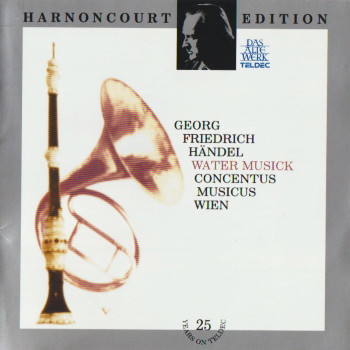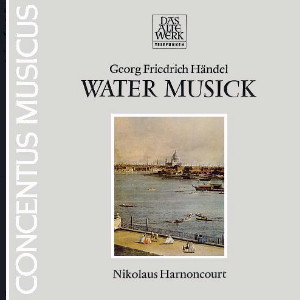 |
1 CD -
Teldec 8.42368 XH (c) 1989
|
 |
| 1 LP -
Telefunken 6.42368 AW (p) 1978 |
|
| NIKOLAUS HARNONCOURT - 25 Years
on TELDEC |
|
|
|
|
|
|
|
| Georg Friedrich
Händel (1685-1759) |
Water Musick |
|
|
|
|
|
|
|
|
|
-
Overture (Grave - Allegro) |
|
3' 12" |
A1 |
|
-
Adagio e staccato |
|
2' 03" |
A2 |
|
-
(Allegro) - Andante |
|
6' 39" |
A3 |
|
-
(Menuet) |
|
2' 05" |
A4 |
|
-
Air |
|
2' 36" |
A5 |
|
-
(Menuet) |
|
1' 07" |
A6 |
|
- Bourrée |
|
0' 58" |
A7 |
|
-
Hornpipe |
|
1' 12" |
A8 |
|
- (Andante) |
|
4' 24" |
A9 |
|
- (Allegro) |
|
2' 00" |
B1 |
|
- (Hornpipe) |
|
3' 46" |
B2 |
|
- (Menuet) |
|
2' 40" |
B3 |
|
- Aria
(Bourrée) |
|
2' 39" |
B4 |
|
- Lentement
(Loure) |
|
2' 00" |
B5 |
|
- Air
(Bourrée) |
|
0' 32" |
B6 |
|
- Menuet |
|
1' 05" |
B7 |
|
- (Air) |
|
0' 52" |
B8 |
|
- (Gigue I) |
|
0' 30" |
B9 |
|
- (Gigue II) |
|
0' 59" |
B10 |
|
- Coro |
|
0' 56" |
B11 |
|
|
|
|
|
| CONCENTUS MUSICUS
WIEN (mit Originainstrumenten) |
|
| - Hermann Schober,
Richard Rudolf, Tromba |
|
| - Kurt Hammer, Pauken |
|
| - Othmar Berger,
Hermann Rohrer, Corno |
|
| - Leopold Stastny, Traversa |
|
| - Elisabeth
Harnoncourt, Jürg Schaeftlein, Flauti
piccoli |
|
| - Jürg Schaeftlein,
David Reichenberg, Oboen |
|
| - Milan Turković, Fagott |
|
| - Alice Harnoncourt,
Walter Pfeiffer, Peter
Schoberwalter, Wilhelm Mergl, Anita
Mitterer, Ingrid Seifert, Micaëla
Comberti, Veronika Schmidt, Gerold
Klaus, Richard Motz, Violinen |
|
| - Kurt Theiner,
Josef de Sordi, Viola |
|
| - Nikolaus
Harnoncourt, Friedrich Hiller, Violoncello |
|
| - Eduard Hruza, Violone |
|
| - Herbert Tachezi, Orgel,
Cembalo |
|
| Nikolaus
HARNONCOURT, Leitung |
|
|
|
|
|
Luogo
e data di registrazione |
|
Casino
Zögernitz, Vienna (Austria) -
febbraio 1978 |
|
|
Registrazione:
live / studio |
|
studio |
|
|
Producer
|
|
Heinrich
J. Weritz |
|
|
Edizione CD |
|
TELDEC
- 8.42368 XH (242 833-2) - (1 CD -
durata 44' 19") - (c) 1989 - ADD |
|
|
Originale LP
|
|
TELEFUNKEN
- 6.42368 AW - (1 LP - durata 44'
19") - (p) 1978 - Analogico |
|
|
Note |
|
-
|
|
|
|
|
Handel's Water
Music, in the form in
which we know it, is a
superdirnensional orchestral
suite which possibly is
a combination of smaller
suites composed at
various times and for
various occasions. Musically, it
is possible to distinguish
among three groups of movements
- in F majorand D minor, in D
major and in G major and G
minor. However, it is uncertain
whether these were in fact three
suites written for the three
more or less well-documented
functions involving "water
music", that is to say, royal
boat trips on the Thames in
1715, 1717 and 1736. Even the
first parts edition, published
by John Walsh in London in 1732
or 1733, combines under the
title "The Celebrated Water
Musick" movements in all three
keys, but totals "only" twelve
movements. Walsh's later edition
for harpsichord - "Handel's
Celebrated Water Musick
Compleat" (around 1743) - adds
nine movements, but nevertheless
is still not yet "compleat". The
most complete contemporary
source, a scope copy which
probably originated from
Handel's copyst John Christopher
Smith jr., incorporates all the
movements in the sequence usual
today, excepting No. 10, which
comes from Walsh's printed
parts. Presumably the score copy
was conceived as a kind of
stocktaking operation, while
Walsh published whatever
happened to come into his hands.
As was so often the case, Handel
himself will have taken from the
twenty movements the one
suitable for a certain
performance. Similiarly the
original suites, if there were
really several of them, were
each composed for a special
occasion, and precisely only
this occasion, not beeing
conceived as "works" which in
binding shape and movement
sequence should have survived
the times. Nevertheless they
have survived, thanks to their
quality.
Ludwig
Finscher
(English translation by
Frederick A. Bishop)
|
|

